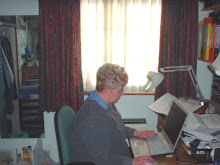
After "getting things in order" as described in my last post, the next priority was to redraw my map for St Andrew's Ward. It now looks like the diagram above which, I assure you, in another bit of software, I can blow up to something that can be seen.
Yonge Street is at the rightmost edge, Strachan Avenue at the left. Divisions One (pink) and Three (turquoise) stretch from Queen West in the north to Adelaide on the south. The east-west boundary between them was York Street. District Two was the Adelaide-King West corridor from Yonge to Peter Street, beyond the old grounds of Upper Canada College. Divisions Four and Five stretched from Queen to King. Division Four started at Peter and ended at Portland Street, Division Five continued on from there to Strachan.
With all that done I could get back to inspecting the households and matching the inhabitants up to the city directories. Division Four started at the southwest corner of Queen and Peter, a tavern named "The Toronto Inn" run by Mrs C McDonagh. From there to Portland Street were two bakers (and another one on the southwest corner of Queen and Portland), a confectioner, one provision dealer, four grocers and a flour dealer handily situated to serve them all. The aroma early in the morning must have been quite something.
By Mitchell's Directory of 1864 a lot of the businesses had changed hands. The flour dealer had died and his business had been taken over by someone else. Police Station No 3 had appeared in the middle of the block between Peter and Brock. William Stewart, a painter living at 367 Queen, had become an artist.
The family that grabbed my attention was that of William Reeves, the baker on the southwest corner of Queen and Portland. He was 53 and his wife, Mary, was 45. Their household included nine children, two living-in bakers--one of whom was probably a nephew, and William's father, Richard, aged 83. Richard, surprisingly, was not a widower but married. Down the street about half a block was a clerk in his thirties named Henry Floyd with his wife Christina, three children--and his mother-in-law, Christiana Reeves, aged 74. Christiana was married--just like Richard. How interesting. The bakery must have been so bursting at the seams that Mother had had to move in with a married daughter. I wish I could prove the relationship between Richard and Christiana, but the 1851 Toronto census is missing and the couple were probably married in Ireland in the early years of the 19th century.
Simply out of curiosity, I would like to know when Richard and Christiana died. But until 1869 and civil registration, the only deaths to be found online are of people buried in the Necropolis. The Reeves family weren't there. Mitchell's Directory does state that William Reeve's bakery had turned into a grocery store run by Mary Reeves, "widow of Wm", by 1864. The Floyds were one of the families to move away from Queen Street--they were found near Hayter on Elizabeth Street by 1864. I wonder if Christiana was still with them?




